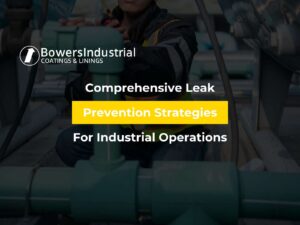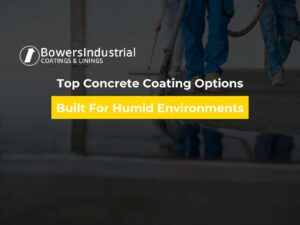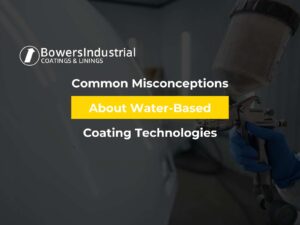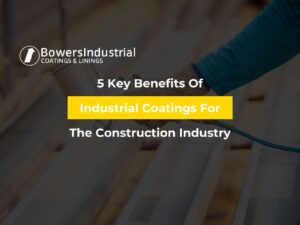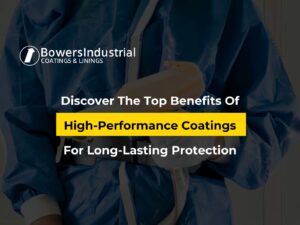Choosing The Right Coating To Prevent Moisture Damage & Cut Facility Costs
Humidity is often underestimated when it comes to concrete durability. While it may seem like a harmless part of the environment, high moisture levels can significantly compromise the performance of concrete coatings—especially in industrial settings where floors are expected to last under constant stress.
Below, we’ll explore which coatings offer the best defense against humidity and how the right choice can save your facility time, money, and future repairs.
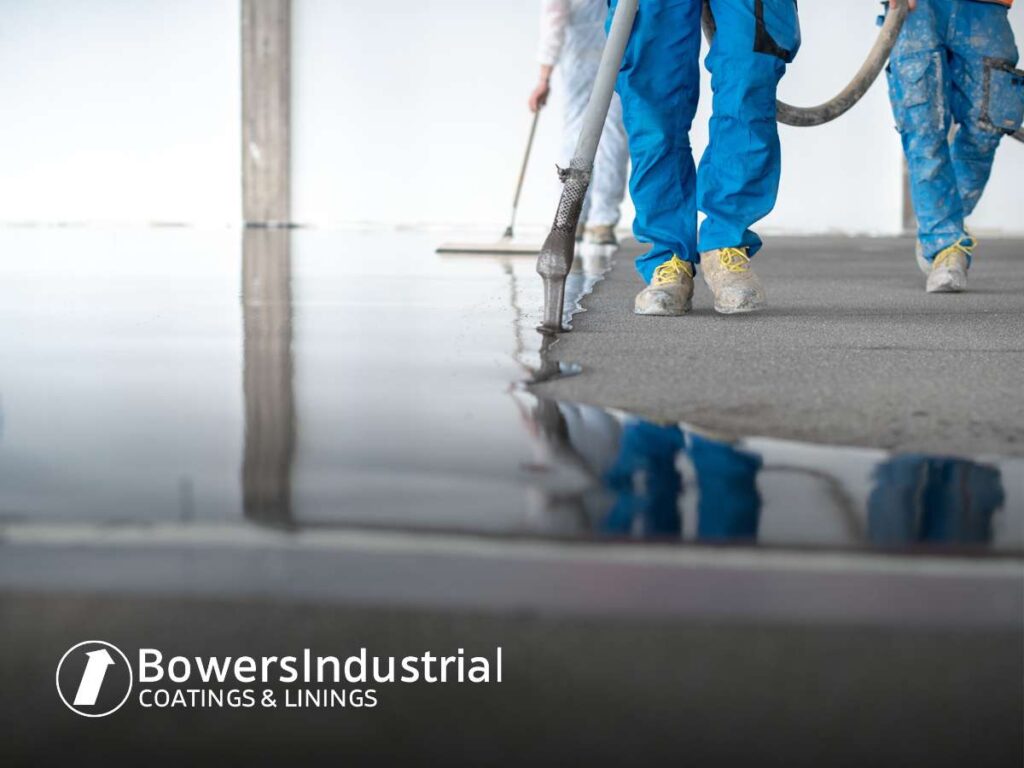
The Hidden Impact Of Moisture On Concrete Floors
Concrete might look impenetrable, but it’s actually porous. In humid environments, moisture vapor rises invisibly through the slab. If your coating isn’t designed to handle that vapor pressure, it will start to fail—often sooner than expected.
Common signs of coating failure caused by moisture include:
- Blistering and bubbling on the surface.
- Edges peeling away from the concrete.
- Staining caused by trapped moisture.
- Uneven or soft areas under foot.
Once these issues begin, they only get worse with time. The worst part is that replacing a failed coating often costs far more than doing it right the first time. That’s why using high-quality concrete repair products is crucial to properly address these problems and prevent recurring damage.
What Makes a Coating Humidity-Resistant?
Choosing the right product starts with understanding what makes a coating work well in humid environments. These are the features that truly matter:
Moisture Vapor Tolerance
Concrete slabs naturally allow moisture vapor to move upward from the ground below. This vapor is often invisible but persistent, and if a coating isn’t designed to handle this pressure, it can cause bubbling, blistering, or peeling of the surface.
Coatings with high moisture vapor tolerance act as effective vapor barriers, blocking this movement and protecting the bond between the coating and the concrete. This characteristic is especially important in humid climates or buildings lacking adequate vapor barriers beneath the slab.
UV & Heat Resistance
Floors exposed to sunlight or high temperatures face accelerated wear due to UV radiation and thermal stress. These elements can cause discoloration, chalking, and brittleness in coatings over time.
When combined with humidity, UV and heat damage intensify, breaking down the protective layer faster. Selecting coatings with UV stability and heat resistance help preserve both appearance and durability for the long term.
Flexibility
Concrete expands and contracts due to fluctuations in temperature and humidity. These subtle movements can place stress on coatings, especially those that are rigid.
Coatings that lack flexibility tend to crack or delaminate as the concrete shifts. Flexible coatings, however, absorb and adapt to these changes without breaking, maintaining adhesion and providing long-lasting protection even under changing environmental conditions.
Chemical & Abrasion Resistance
Humidity isn’t the only factor that challenges industrial floors. Many facilities also expose their concrete to chemicals, oils, cleaning agents, and heavy machinery, as well as constant foot or vehicle traffic.
Coatings that combine moisture resistance with strong chemical and abrasion resistance—like chemical resistant concrete—offer superior protection. They shield the substrate from chemical damage and mechanical wear, reducing the need for frequent repairs and minimizing downtime.
Coating Systems That Stand Up To Humidity
Protecting concrete in humid environments requires more than just a standard sealer. Excess moisture in the air—and sometimes within the concrete slab itself—can lead to coating failure, blistering, or delamination. That’s why it’s essential to select a system specifically engineered to handle moisture exposure without compromising durability or aesthetics.
Here are three high-performance coating solutions that continue to prove their value in demanding commercial and industrial settings.
1. Polyurea Coatings
When time is limited and performance can’t be compromised, polyurea stands out as a go-to solution. This advanced coating technology forms a highly elastic, seamless membrane that adheres tightly to concrete—even in less-than-ideal moisture conditions. Unlike slower-curing systems, polyurea sets within minutes, significantly reducing downtime and the risk of contamination during installation.
Thanks to its ability to resist moisture vapor transmission and mechanical stress, polyurea is frequently used in demanding environments such as:
- Warehouses.
- Vehicle service areas.
- Outdoor patios and walkways.
- Loading docks.
Beyond its rapid application, polyurea’s chemical structure offers long-term protection in environments where abrasion, UV exposure, or chemical spills are concerns. This makes it particularly valuable in facilities that operate around the clock, where interruptions for maintenance are costly.
2. Polyaspartic Coatings
For projects where aesthetics matter just as much as performance, Polyaspartic coatings strike an ideal balance. As a cousin to polyurea, this technology provides many of the same moisture-resistant benefits, while also allowing for design versatility—glossy finishes, tinted colors, or decorative flakes are all possible without sacrificing durability.
This makes Polyaspartic systems a favorite for applications such as:
- Retail spaces.
- Restaurants and food prep areas.
- Residential garages.
What sets Polyaspartics apart is their fast-curing capability combined with excellent UV stability and abrasion resistance. Installers can complete jobs in a single day, and owners benefit from a floor that’s both visually appealing and resilient against wear and harsh cleaning chemicals.
In humid climates, coating solutions like industrial floor coating, for example, offer the moisture resistance and durability needed to keep finishes looking great and performing well for years.
3. Moisture-Mitigating Epoxy Systems
Humidity presents a particular challenge for epoxy coatings—but moisture-mitigating epoxies are designed to address this vulnerability head-on. These formulations act as a vapor barrier by deeply penetrating the concrete and blocking moisture transmission from within the slab.
While they’re often used as primers, they are essential components of multi-layer systems designed for long-term performance. You’ll commonly find these systems in:
- Manufacturing floors.
- Laboratories.
- Food and beverage production areas.
Though installation requires careful preparation and extended cure times, the benefits are significant: strong substrate adhesion, improved bond strength for topcoats, and reliable performance under heavy foot traffic or equipment use.
When applied beneath polyurea or polyaspartic layers, these primers help ensure the entire coating system remains intact—even when ambient or internal moisture levels fluctuate dramatically.
Humid Environments Demand More Than Just “Tough” Coatings
Strength by itself isn’t enough to prevent coating failure when a system isn’t engineered for the specific climate challenges. This is especially important in facilities where conditions change rapidly throughout the day. Consider food processing plants where steam, cleaning solutions, and temperature swings put extreme stress on floors. Or industrial sites where humidity pairs with chemical exposure, creating a demanding environment for any surface.
That’s why choosing coatings like chemical resistant concrete that are designed to handle both moisture and harsh chemicals is critical to maintaining long-term durability and safety.
Protect Your Floors Today: Don’t Let Humidity Win
Humidity might not seem like the biggest threat to your facility’s floors, but ignoring it can lead to costly repairs and downtime. Luckily, modern coating technologies deliver high-performance protection without compromising on installation speed, appearance, or durability.By selecting the right coating system and working with our experienced team at Bowers Industrial that understands your unique needs, we can help you extend the lifespan of your concrete and prevent avoidable damage. Contact us today.

Bowers Industrial Coatings & Linings
2381 S 2700 W, Unit B
West Valley City, UT 84119
Tel: 801-977-0508
Email: [email protected]

